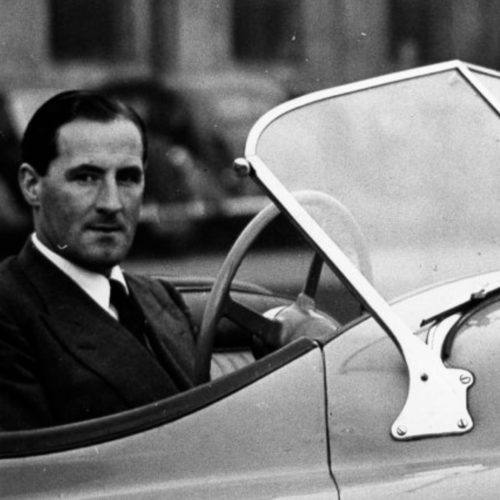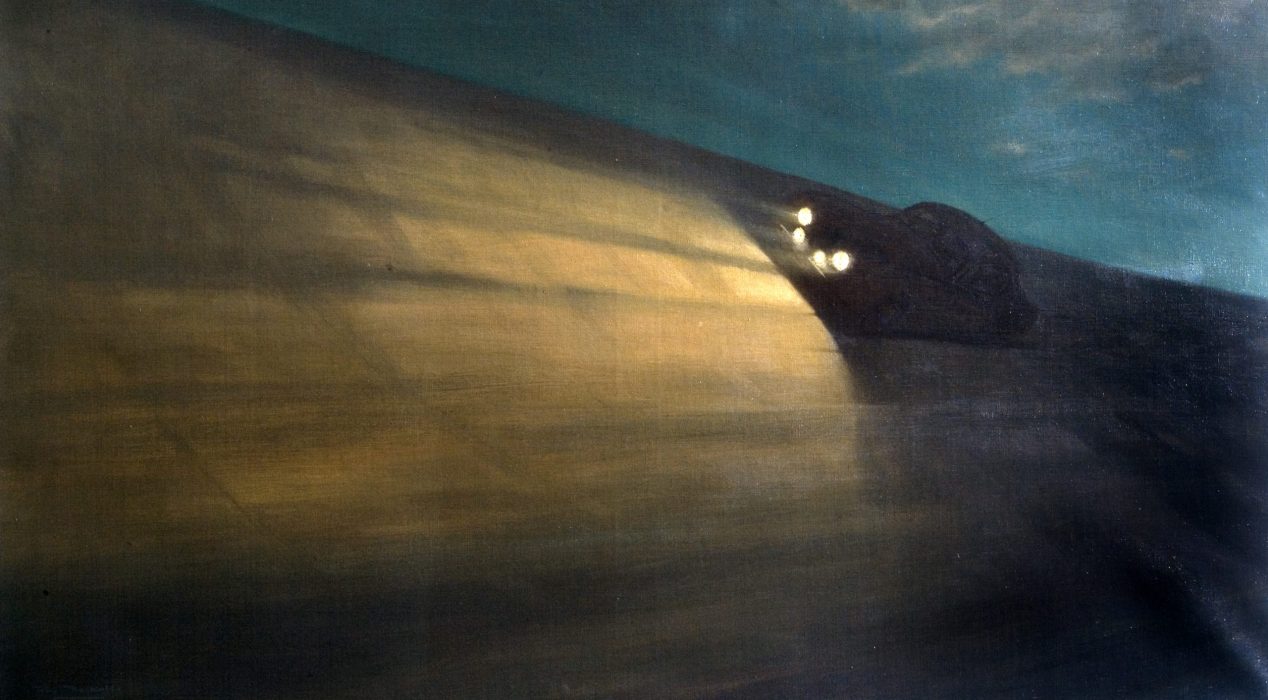
Jaguar XK120 LWK 707 at Montlhéry, Roy Nockolds, 1952
The Artwork
This is one of nine paintings by artist Roy Anthony Nockolds in the Jaguar Daimler Heritage Trust’s Collection, most of which were commissioned by Jaguar Cars, and depicts the Jaguar XK120 Fixed Head Coupe – LWK 707 which was driven by Stirling Moss, Jack Fairman, Bert Hadley and Leslie Johnson around the oval track at Montlhéry, north of Paris, at over 100 mph, 24 hours per day for seven days and nights in August 1952.
This is a real example of Nockolds’ use of light and dark to give drama to his work. The track at Montlhéry is banked allowing the car to be driven at a constant speed with no need to slow down for corners and LWK 707 is shown up high on the banking at night with both its headlamps and driving lamps lit to illuminate the track in front. The shape of the XK120 coupe is only just discernible against the darkness of the track below and behind, and the half-lit night sky above. The focus of the picture and hence the drama comes from his use of light. A car cannot sustain a position high on banking unless it is being driven at speed and the two thirds of the painting illuminated by the lights give it a real sense of speed.
The painting is currently on public display in the Collections Centre at the British Motor Museum at Gaydon. When first hung the picture looked very dull and uninteresting and it was only when extra lighting was added that it truly came alive.
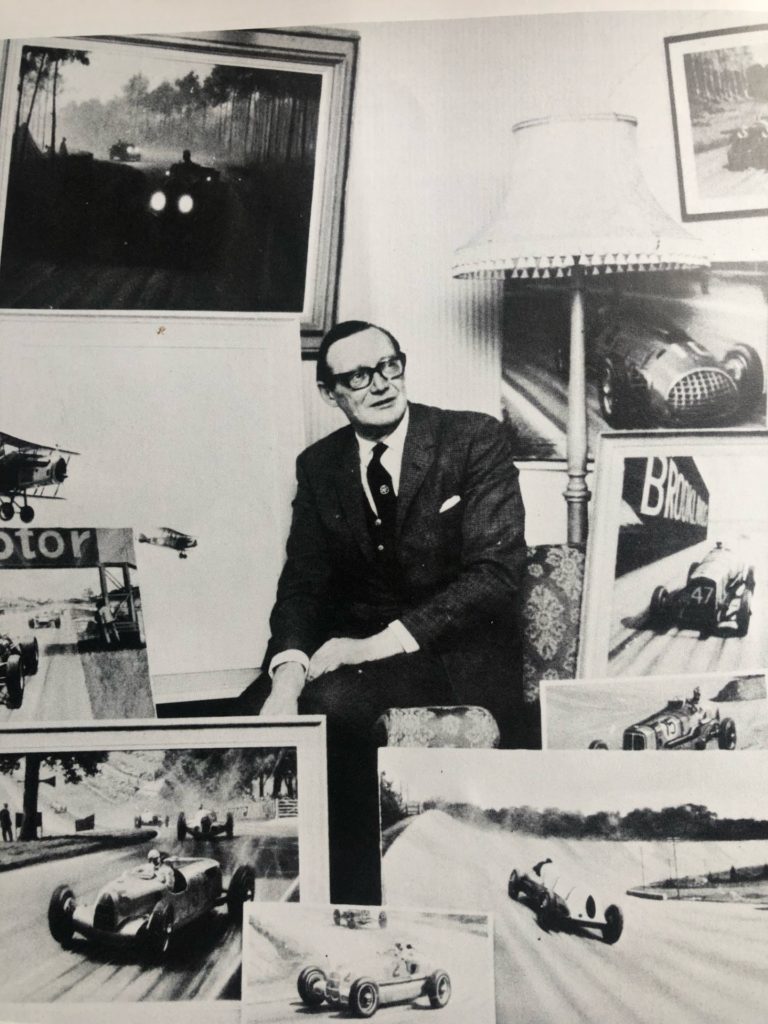
The Artist
Roy Nockolds was born in Croydon in 1911. He always claimed that his only successful subject was art and this was confirmed by two certificates from the Royal Drawing Society in 1922 (age 11) and 1923 (age 12). According to Nockolds’ recollections he first visited Brooklands in 1924 (age 13) where he became impressed by the power and speed of the racing cars and within two years, he was producing motoring art. By the time he was in his teens he was getting his pictures published in the motoring press. His early work was mainly pencil and charcoal drawings, but he also used ink, scraperboard, lino cut and dry point etching as well as watercolours.
F Gordon Crosby was already illustrating for The Autocar and Nockolds was fortunate to have most of his early work published by Motor Sport and Light Car. Although to his credit, Autocar was publishing full page reproductions of some of his etchings in 1932 (age 21). The first recorded exhibition of his work was in December 1934 at the Lombard Restaurant, Cheyne Walk, Chelsea. Around this time he was working as a freelance artist although some of his work was being used by The Motor to illustrate a weekly series of famous corners on racing circuits.
The start of war in 1939 brought a cessation of motor racing for the duration and Nockolds carried on working from his London studio as a general illustrator and for the services, particularly the RAF producing propaganda art.
[Photo courtesy of Nockolds’ daughter Rosanna Hackett]
In 1942 he was asked to look at improving the camouflage of night fighters. He noticed that a white owl was more difficult to see against a night sky than a dark bird. His idea was to paint the leading edge of the wing and underside of the aircraft white and the top of the aircraft black making it difficult to see from above and below. He prepared a painted model of a De Haviland Mosquito aircraft which was transferred to a full sized plane, resulting in the whole of 151 Mosquito Squadron being converted to the new scheme within days. Other camouflage work led to him being called up into the RAF, at the end of 1942 initially as a Clerk, but by 1943 he was posted to the aircraft research station at Farnborough where he had civilian status. He continued the propaganda paintings and his work on camouflage of aircraft, particularly bombers and accepted commissions to supplement his income. The end of the war saw the restart of racing and he resumed his motoring artworks including commissions from car makers such as Ford, Standard, Rover, Rolls-Royce and the Rootes Group and component manufacturers such as Lockheed and Lucas.
It was during this period that he was commissioned by Jaguar and some of the sponsors and suppliers to produce all the paintings that we have in our Artwork Collection. Nockolds’ connection with Jaguar began when the Esso Petroleum Company commissioned him to depict Le Mans 1951 when Peter Walker and Peter Whitehead drove their C-type through pouring rain to give Jaguar their first victory at Le Mans. He then worked closely with Jaguar’s PR Manager Ernest (Bill) Rankin for the next decade undertaking a series of commissions, many of race winning situations but also pictures for calendars, Christmas cards and advertising posters. He was a master of combining light and texture into his work to give the impression of speed and this comes across in several of our paintings.
His work was displayed in many exhibitions in the UK and twenty-four of his paintings were exhibited in New York in 1960 in an exhibition entitled ‘British Motoring Achievements’. This was a collection of paintings depicting outstanding performances of British cars during the previous ten years including some of our race winning Jaguar pictures.
Nockolds took a very keen interest in the Brooklands society founded in 1967, being an early Committee Member and the Chairman from 1976 to 1978, only resigning with the onset of ill health. He was elected Chairman of the Guild of Aviation Artists in 1975, and continued to paint late into his life before passing away in 1979.
The Car
In August 1952 this specially prepared car was taken to Montlhéry near Paris and was driven for seven days and seven nights at an average speed of 100.32 miles per hour, including all stops.
There were four drivers: Stirling Moss, Jack Fairman, Bert Hadley and Leslie Johnson – who had conceived the record attempt following previous 1 hour and 24 hour record runs.
Montlhéry’s concrete surface was rough, and the Jaguar broke a spring when it was already well into the run. No spare was carried on board. Regulations stipulated that an outside replacement would make the car ineligible for any further records beyond those already achieved before the repair.
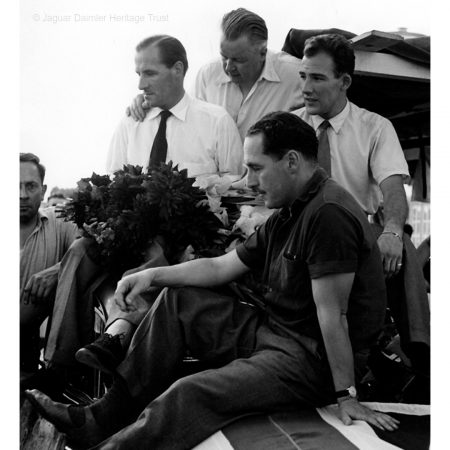
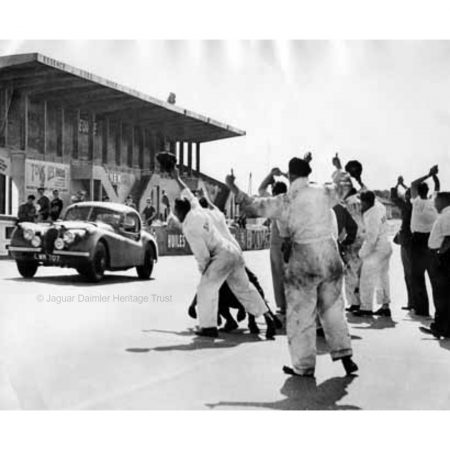
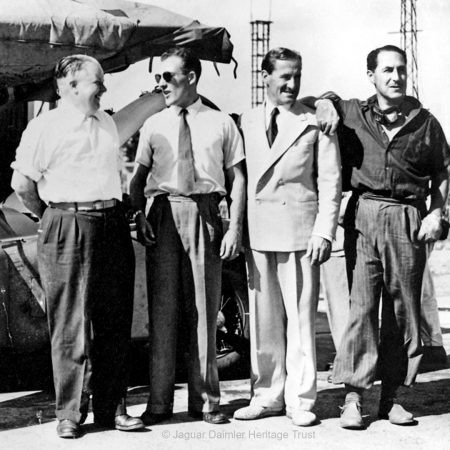
Johnson drove for nine hours to save the other drivers from added risk while the speed had to be maintained on the broken spring. When he finally stopped to have it replaced, the car had taken the following records:
- World and Class C, 72-hour records at 105.55 mph
- World and Class C, four-day records at 101.17 mph
- Class C, 10,000 kilometre record at 107.031 mph
- World and Class C, 15,000 kilometre records at 101.95 mph
- World and Class C, 10,000-mile records at 100.65 mph
After the repair the car went on to complete the full seven days and nights, covering a total of 16,851.73 miles (27,120.23 km) at an average speed of 100.31 mph (161.43 kmh).
For more information on Leslie Johnson and the Montlhéry 24/7 record breaking run, click here
Following the record run, the car was retained by Jaguar Cars and regularly used for PR purposes. When the Jaguar Daimler Heritage Trust was setup in 1983 ownership of the car was transferred from the Company to the Trust and it remains with us. It is normally on display either in the Jaguar section of the British Motor Museum at Gaydon or in the Collections Centre. The car is MOTed annually and kept in running and driving condition. It returned to Montlhéry a number of times and was run at Goodwood, Coventry Motofest and numerous other Jaguar related events. There is also a bronze plaque at Montlhéry commemorating the event.
Click the button for more information on LWK 707:
